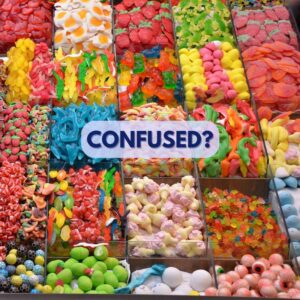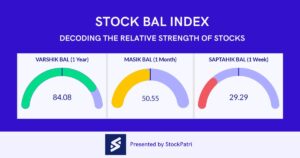How to explain Stock Market to a Child?
Isn’t it a wonderful experience to look at the world through a child’s eyes? In particular, the world of stock market investing, that has stumped even the best of professionals. So, how about looking at the stock market through the eyes of a child? How can we explain stock market to a child?
There is no better way to explain a concept to a 5 year old, than through a story that begins with the evergreen phrase ‘ Once upon a time’! So, let us dive into this story about a group of kids in a candy story, where every element of the story represents things related to the stock market!
The Candy Store – A story about the Stock Market
Once upon a time, there was a huge candy store, where children could buy thousands of different candies. However, these were no ordinary candies.
A group of fairies had made these candies, and had sprinkled some magic dust on them. Some of these candies would become sweeter over time, while others would turn sour. You could not find out which one would turn sweet or sour, just by looking at the candies.
The Price Mechanism
The candy store owner has a secret diary, and would record the sales of all candies. He was a very smart guy, and had all the data about each and every candy.
He knew who was buying which candy, and how many of them. He even knew who wanted to buy which candy and the price that each of the children were willing to pay to buy the candy.
In the same manner, he also knew everything about the children wanting to sell their candies, and the price at which they had sold, or were ready to sell their candies.
If the kids bought more of one type of candy, the owner increased the price of that candy.
If the kids sold or wanted to return or exchange their candy, the store owner reduced the price of that candy.

In this way, the shop owner ensured that there was a balance maintained between children who wanted to buy and those that wanted to sell any given candy. If more children wanted a particular candy, the price would increase. If the candy was not sweet enough for the higher price, some of them would switch to other candies, and this would bring down the price of the expensive candy a little bit.
The Market Participants
Enough said about the candies. Now, let us look at the children in the candy store. So, why were they so interested in the candy store?
What were the children trying to get out of these visits to the candy store and by buying and selling these magical candies?
Each child was given some pocket money every month. Most of that money would be spent on their expenses, such as buying food, stationery, etc.
However, the children wanted to do more.
Some of them wanted to buy a nice set of dinky cars. Others wanted a house for their dolls. Most of these toys were very expensive.

Even if the kids put their pocket money in a piggy bank, it would have taken them many years before they could buy some of these expensive toys. And, to make matters worse, the toy shop owner kept increasing the prices of these toys every year.
Investing to meet goals
Clearly, just putting the extra pocket money that they saved each month in a piggy bank would not help them buy these expensive toys. So, they approached their teacher, who explained to them how the candy store could help them.
The teacher told them to buy the magical candies from the candy store with the pocket money they saved each month, instead of putting all that money in the piggy bank. Since these candies had magical properties, some of them would become sweeter over time. As other children would want more of this candy, the price would increase too.
This way, the children could sell their candies at a higher price in future, and buy the expensive toys that were out of their reach until now!
The Investor Class
So, how do you think the children reacted to this advice and what did they do at the candy store?
Since all of them were different from each other, they all did different things.
Some of them would spend all their pocket money, and they did not save anything to buy candies. They would skip the visits to the candy store altogether.
Some of the other children, who did save some pocket money each month, started visiting the candy store.
During these visits to the candy store, they saw thousands of candies. They did not know what to do, and which one to buy?
They were confused.

And, in this confusion, they would either grab the nearest candy, or the most shiny and beautiful ones. Some of the kids would just look at what other people were buying in the candy store, and would queue up to buy those candies.
The Smart Investor
However, the topper of the class was different. His behavior in the candy store was completely different.
Unlike other kids, he did not rush to grab the nearest candy, or the most shiny ones.
He did not blindly follow others. Instead, he looked very carefully at things around him and noted them in his personal diary.
He was a curious child, and wanted to know the most important things about the candies.
His curiosity led him to read more about the fairies that made each of his favorite candies.
He got to know the fairies better, and he realized something very important. The good fairies will probably make better candies that will become sweeter over time, and their price will also increase.

If their magic dust worked wonders in the past, it was likely that they were good enough to do it again.
So, it was as important to look at the background of the fairies who made each of the candies, as it was to look at the candies themselves.
Data-Driven Insights
This topper kid was very diligent and smart. He kept a note of everything he learnt and observed about the candies, the fairies and things happening in the candy store.
He kept a record of the key things for all his favorite candies.
He could flip the pages of his diary and tell you anything you would want to know about any of his candies.
How sweet are the candies?
Have the candies become sweeter over time?
What is the price at which these candies were selling earlier vs the current price?
Are more kids wanting to buy this candy over a period of time?
The topper kid would routinely look back at all the pages in his diary, and try to find some patterns.

He was able to identify the candies that have turned sweeter in the past, and might continue to become sweeter in the future.
He bought these candies, and wanted to buy more of them in the monthly visit to the candy store. He continued doing this each month.
Portfolio Management
After a few visits, he realized that not all his candies had the same level of magic.
Some of them did not turn as sweet as he was expecting.
He needed to sell some of these not so good candies and buy more of the better candies.
So, he would turn back to his trusted diary once again.
He would find candies that have turned sour in the past, or are likely to turn sour in the future, and sell them.
He would continuously look at other candies too, that were not part of his favorite list earlier.

He started buying these candies if they turned out to be better than his old favorites.
Discipline and The Magic of Compounding
The topper kid continued doing this each month. He studied candies each month, as seriously as he would have done one day before the final exams!
Can you imagine what happened at the end of the year? And, what would happen when he moved from junior school to high school?
At the end of the year, the topper had the sweetest candies in the class. Plus, the fairies kept giving him bonus candies from time to time too!
Those expensive things that he wanted, such as the doll house and the dinky cars, were still some distance away. However, he seemed to be getting there, and was at least moving in the right direction.
The Average Investor
What do you think happened to most of his classmates?
The ones who did not save their pocket money were not happy.
They could clearly see that they would not be able to buy the expensive toys, even though they were currently enjoying their lives by spending all of their pocket money. But, the future was not as bright!
The ones who had grabbed whatever candies came their way, or blindly followed others, were not doing too well either.
Some would do well in one term, but they would not do quite well in the next term.
Many of the kids were sitting on a pile of sour and rotten candies. They had very little money to buy that expensive house or those hot wheels.
Moral of the story
As with many children’s stories, there is a moral of the story for this one too!
This story is obviously not just about children buying magical candies at a large candy store, so that they can earn enough money to buy expensive toys.
It is about ordinary investors buying stocks in the stock market to make enough returns to meet their personal finance goals.
It is a wake-up call to all retail investors and traders, who can re-write their report cards, aka financial patri, with a disciplined data-driven approach – Data as a compass, Discipline as a guide!
Let us know your thoughts on this story, and your behavior at the candy store i.e the stock market?
We would love to hear from you even if someone else is making the trip to the candy store on your behalf, or even if you are not into candies, but you are into chips or chocolates (other asset classes).
May the (best) fairy be with you, so that you can have your candy, and eat it too!



